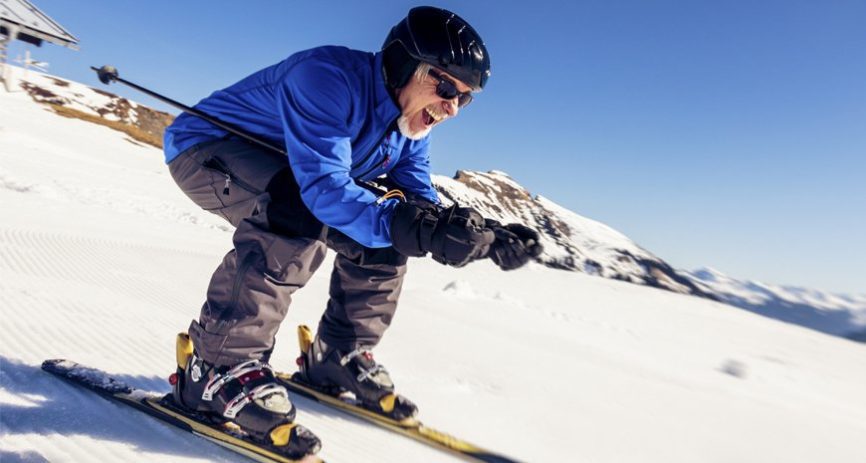
6 tips to winterproof your workouts
When winter rolls into town, it can be tempting to stay inside and devour all of the comfort food in sight. And the urge to do so isn’t really your fault.
You see, according to research from the University of Exeter, humans have developed a subconscious impulse to do exactly that during the winter months. During winter, when food is naturally scarce, our instinct to maintain body fat is strong, which naturally leads us to indulge in sweet, fatty and unhealthy food.1
But this can quickly tip the scales in the wrong direction. According to Lawrence J. Cheskin, MD, founder, and director of the Johns Hopkins Weight Management Center, people tend to gain five to seven pounds on average during the winter months.2
One way to combat this winter weight gain is through exercise. However, subzero temperatures, ice-covered sidewalks and shorter days can make fitting in winter workouts difficult.
If Old Man Winter is forcing your fitness into hibernation, here are six tips to help winterproof your workouts.
1. Embrace the season
Rather than resisting the winter season and all of the weather-related issues that come along with it, why not use the weather to your advantage? Skiing, snowboarding, ice skating, sledding and snowshoeing are all great winter exercise options. Even shoveling snow can be a great workout! According to Harvard Heart Letter, a newsletter published by Harvard Medical School, a 125-pound person can burn 180 calories, a 155-pound person can burn 223 calories and a 185-pound person can burn 266 calories per half hour of shoveling snow.3
2. Head inside
Okay, so maybe being outside when it’s freezing cold simply isn’t your thing. That’s fine, too! There are plenty of ways to stay inside and stay fit during winter.
Joining a gym is an obvious solution, but if you don’t want to get roped into a year-long contract, find a no-commitment gym membership that allows you to cancel at any time. This way, you can go to the gym during the cold months and cancel when the weather warms—and continue your workout regimen outdoors.
Signing up for exercise classes is another indoor option. Whether it’s spinning, yoga, dance or racquetball, classes can get your blood pumping during winter—and be a lot of fun to boot!
Finally, if you’re more of a homebody, bring your workout indoors with the help of workout videos. Purchase workout DVDs online or in-store, or consider a subscription to an online workout video membership.
3. Get the right gear
It’s easier and safer to exercise during winter when you have the proper workout clothing and accessories. Purchasing proper gear may be a bit of a monetary investment. However, it will not only keep you safe but also help motivate you to make your purchases worthwhile.
As far as clothes go, be sure to avoid cotton, which can hold onto moisture and make you cold. Instead, wear a moisture-wicking material closest to your skin, such as a synthetic polypropylene or Capilene. On top of that, layer a fleece or wool pullover for insulation. For your outer layer, go with a wind- and water-resistant jacket made from nylon or Gore-Tex. Also grab a wool hat, some knit gloves, a ski mask and footwear that can handle the elements. Trail-running shoes with deep treads will help maintain your grip on slippery surfaces, and if you spray them with a waterproofing solution, they’ll be able to withstand the wet better. Or, you could opt for a pair of traction cleats that wrap around your shoes for the best traction on snow and ice.
4. Find a workout buddy
Exercising with a friend increases accountability. Find a friend who also wants to stay fit during winter and make a commitment to train together. When you exercise with someone else, you’ll be forced to keep more of a set schedule, which will prevent you from procrastinating or skipping workouts. Plus, chances are you’ll have more fun exercising with a friend than going it alone!
5. Refresh your playlist
Something about a good music playlist can inspire a great workout—no matter how cold it is outside. In fact, studies show music can even help us increase our effort and stamina during exercise. 4 Plus, it can make even vigorous workouts feel fun. Find some new music to get you going, keeping in mind that the best exercise music features between 120 and 140 beats per minute.4
6. Get more sleep
It’s difficult to get out of bed on winter mornings, not just because of the cold, but also because of the late sunrise. Darkness cues your brain to produce sleep-including chemical melatonin, 5 leaving you groggy and reaching for the snooze button. Going to bed earlier will help you get up earlier, ready for your workout. In turn, your workout will then help you sleep better at night.6 (See how your workout affects your sleep and your sleep affects your workout?!)
Aim to get seven to nine hours of sleep per night7 and follow these tips to improve your quality of sleep:6
- Stick to the same sleep schedule every day.
- Exercise regularly, but not too late in the day.
- Ensure your bedroom is quiet and dark.
- Keep your bedroom temperature between 60- and 67-degrees Fahrenheit.
- Use a comfortable and supportive mattress.
- Avoid your phone, TV, computer, and tablet before bed.
- Don’t consume caffeine after 2 PM.
- Avoid alcohol and avoid eating before bed.
- Make your evenings relaxing.
- If you continue to struggle with sleep, talk to your doctor.
Winter doesn’t need to be a season of hibernation
If you follow these winter workout tips, you’ll emerge this spring fit, healthy and ready for warm weather!
1University of Exeter, People face subconscious urges to overeat at this time of year, http://www.exeter.ac.uk/news/featurednews/title_489377_en.html, January 6, 2016.
2Eat This, Not That!, 20 Reasons We Tend to Gain More Weight in the Winter, https://www.eatthis.com/why-gain-weight-in-winter/, November 28, 2018.
3Harvard Heart Letter, Calories burned in 30 minutes for people of three different weights, https://www.health.harvard.edu/diet-and-weight-loss/calories-burned-in-30-minutes-of-leisure-and-routine-activities, August 13, 2018.
4Psychology Today, The Many Health and Sleep Benefits of Music, https://www.psychologytoday.com/us/blog/sleep-newzzz/201812/the-many-heath-and-sleep-benefits-music, December 13, 2018.
5National Institute of Neurological Disorders and Stroke, Brain Basics: Understanding Sleep, https://www.ninds.nih.gov/Disorders/Patient-Caregiver-Education/Understanding-Sleep, December 2, 2018.
6Healthline, 17 proven tips to sleep better at night, https://www.healthline.com/nutrition/17-tips-to-sleep-better, November 2, 2018.
7Lowcountry Parent, 40 percent of Americans are sleep deprived largely due to bad habits, say local experts, https://www.postandcourier.com/lowcountryparent/percent-of-americans-are-sleep-deprived-largely-due-to-bad/article_1675a2a3-0d18-5b4a-a6c6-f60a4ca63de5.html, December 31, 2018.
